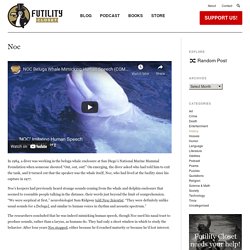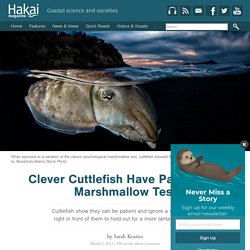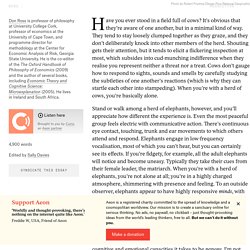

Noc. In 1984, a diver was working in the beluga whale enclosure at San Diego’s National Marine Mammal Foundation when someone shouted “Out, out, out!”

On emerging, the diver asked who had told him to exit the tank, and it turned out that the speaker was the whale itself, Noc, who had lived at the facility since his capture in 1977. Noc’s keepers had previously heard strange sounds coming from the whale and dolphin enclosure that seemed to resemble people talking in the distance, their words just beyond the limit of comprehension.
Clever Cuttlefish Have Passed the Marshmallow Test. Article body copy Good things come to those who wait—especially for the cuttlefish hanging out with Alexandra Schnell, a comparative psychologist at the University of Cambridge in England.

For the past decade, Schnell has been digging into cephalopod behavior and cognition by giving them tests traditionally used to measure brain power in primates and other vertebrates. And the squishy creatures are performing remarkably well. In fact, a new study suggests that cuttlefish can display self-control. When given the choice, some individuals opt to forgo instant gratification if it means they can get a better reward down the line. Six subadult cuttlefish took the test, a riff on the well-known marshmallow test first performed by Stanford researchers some 50 years ago. Scientists make first living robots from frog cells. A team of scientists at Tufts University in the US have created xenobots, tiny robots made from frog skin and heart cells that can walk, work together and heal themselves.

Algorithms define the configurations of frog cells, which are then constructed by humans to create a living robot that the scientists have called a xenobot, after the Xenopus laevis species of frog they are made from. These aquatic organisms live for up to seven days, and the team hopes that in future they can be used to deliver drugs into people's bloodstreams, clean up microplastics from the ocean, or manage radioactive waste spills. A number of variations of the 0.7 millimetre-long robots are designed using a computer algorithm. "Computers model the dynamics of the biological building blocks (skin and heart muscle) and use them like LEGO bricks to build different organism anatomies," said the team of scientists.
"It is the survival of the fittest, inside the computer. " Samsung's artificial Neon humans are "a new kind of life" In a bid to "make science fiction a reality", Samsung's future factory STAR Labs has developed Neon, AI-powered virtual beings that look and behave like real humans.

Unlike artificially intelligent (AI) assistants like Siri or Alexa, STAR Labs' computationally created beings aren't programmed to be "know-it-all bots" or an interface to answer users' questions and demands. Can Elephants Be Persons? If Happy the elephant were allowed to live a natural life in the wild, she would likely spend her days roaming miles of tropical forest and plucking fruit and leaves from trees with the finger-like tip of her trunk.

Dolphins and Whales Might Experience the World as a Group. There's other evidence for dolphins and whales having an advanced level of social and emotional intelligence.

Some cetacean species possess spindle cells, a special type of neuron related to emotions and social interaction. These neurons are commonly thought of as a uniquely human feature that sets Homo sapiens and some non-human primates apart from the rest of the animal kingdom. However, scientists have also found spindle cells in humpback whales, sperm whales, fin whales, orcas, and bottlenose dolphins (and elephants, but that's another story).
Whales likely have had these cells for at least twice as long as humans — they're believed to have evolved separately in a process called convergent evolution. If elephants aren’t persons yet, could they be one day? Have you ever stood in a field full of cows?

It’s obvious that they’re aware of one another, but in a minimal kind of way. They tend to stay loosely clumped together as they graze, and they don’t deliberately knock into other members of the herd. Shouting gets their attention, but it tends to elicit a flickering inspection at most, which subsides into cud-munching indifference when they realise you represent neither a threat nor a treat. Cows don’t gauge how to respond to sights, sounds and smells by carefully studying the subtleties of one another’s reactions (which is why they can startle each other into stampeding). The Blood of the Crab. Theconversation. Animal Pain and the New Mysticism About Consciousness » IAI TV. Can an Artist Help Captive Elephants Win Legal Personhood? You come upon the elephants slowly—glimpsed while walking down a city street as flickers of color against a building, or as strips of light velcroed to wet air—and then very quickly.

When they emerge fully, they loom enormous from within their video loops. They transform urban scenes and dwarf human inhabitants, appearing both incongruous and inevitable. Of course an elephant flickers across an apartment façade. Why not? Chimps could soon win legal personhood. For the past three years, an attorney has been filing lawsuits in New York state on behalf of four chimpanzees named Tommy, Kiko, Hercules, and Leo.

They are intelligent “persons,” he argues, and should not be kept in cages. Steven Wise, who is also president of the Florida-based Nonhuman Rights Project, believes that the chimps should have the legal right not to be kept in captivity because they are intelligent and self-aware. In December 2013, he sued on their behalf, arguing in several lawsuits that the chimps were “persons” for legal purposes and therefore could not be confined in cages. 150625112010. Thinking Pigs: A Comparative Review of Cognition, Emotion, and Personality in Sus domesticus [eScholarship] Peer Reviewed Title: Thinking Pigs: A Comparative Review of Cognition, Emotion, and Personality in Sus domesticus Journal Issue: International Journal of Comparative Psychology, 28 Author:
![Thinking Pigs: A Comparative Review of Cognition, Emotion, and Personality in Sus domesticus [eScholarship]](http://cdn.pearltrees.com/s/pic/th/comparative-escholarship-109971971)
Pigs Are Highly Social And Really Smart. So, Um, About Eating Them... Was the Golden Rule Born in the Mind of a Monkey? As economic inequality increased in many wealthy nations in recent years, a debate has developed around the question of whether inequality is bad for national economies—and bad for their citizens. A captivating video clip of monkey behavior (see below), taken from a 2011 TED talk by primatologist Frans de Waal, has become a surprising piece of ammunition in this discussion.
Court Rules Orangutan Held In Argentina Zoo Is 'Non-Human Person' And Can Be Freed. By Richard Lough BUENOS AIRES, Dec 21 (Reuters) - An orangutan held in an Argentine zoo can be freed and transferred to a sanctuary after a court recognized the ape as a "non-human person" unlawfully deprived of its freedom, local media reported on Sunday. Animal rights campaigners filed a habeas corpus petition - a document more typically used to challenge the legality of a person's detention or imprisonment - in November on behalf of Sandra, a 29-year-old Sumatran orangutan at the Buenos Aires zoo.
In a landmark ruling that could pave the way for more lawsuits, the Association of Officials and Lawyers for Animal Rights (AFADA) argued the ape had sufficient cognitive functions and should not be treated as an object. The court agreed Sandra, born into captivity in Germany before being transferred to Argentina two decades ago, deserved the basic rights of a "non-human person. " Orangutan is a word from the Malay and Indonesian languages that means "forest man. " Chimpanzee Personhood: What the Judges Said. It's a little unusual for a judge to wish you good luck as you head off to appeal his decision.
But that's exactly what happened when the Nonhuman Rights Project went before the Hon. Joseph Sise in a county court last week. Dolphins aren’t as special as you think. Earth in Transition. Elephants Orphaned by Mass Killings Are Tormented For Decades Afterward. Culling has long been used as a conservation tool to keep elephant populations in check, but a new study shows such killings can psychologically damage groups of elephants for decades. Wildlife officials in South Africa have used culling to manage elephant populations since the 1960s. The environmental benefit is clear: too many of these huge, hungry animals could quickly eat, trample and uproot the vegetation in a fenced nature reserve. To prevent such habitat destruction, managers have historically rounded up the big beasts with a helicopter and had professional hunters on the ground kill some adults. The young elephants are then shipped to other parks.
India Bans Captive Dolphin Shows as 'Morally Unacceptable' NEW DELHI, India , May 20, 2013 (ENS) – India’s Ministry of Environment and Forests has decided to forbid the keeping of captive dolphins for public entertainment anywhere in the country.